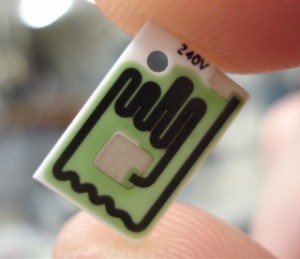Miniature ceramic heaters

A new approach to miniaturised heaters is proving to be outstandingly reliable, versatile and economic.
Miniaturised ceramic heaters capable of independently controlling their dissipation are replacing Nichrome elements universally used until recently in domestic medical and military applications.
It is now possible to mass produce incredibly small controlled dissipation 230 V elements onto small 12 mm x 9 mm ceramic substrates capable of operating at over 350¡ celsius.
Besides heaters the technology can be used for such diverse applications as thermal print heads, molecular gas flow sensors and tracking transmitters.
Thick Film technology is used wherever high reliability is required, such as space satellites and heart pacemakers. Circuit elements are physically printed sometimes in multiple layers on thin ceramic sheets and then fired at high temperature typically 850¡C to form working electronic modules.



